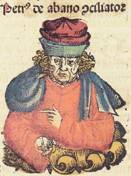Peter of Abano
1259-1316
 Peter of Abano or Pietro d'Abano was an Italian philosopher, astronomer, and medical authority. He served as a professor of medicine in Padua, Italy, an important medieval medical center, which he helped establish.
Peter of Abano or Pietro d'Abano was an Italian philosopher, astronomer, and medical authority. He served as a professor of medicine in Padua, Italy, an important medieval medical center, which he helped establish.
Peter translated "Problems of Aristotle" from the Greek into Latin. He also wrote a book Adviser in points of controversy, to reconcile the Greek and Arabic medical doctrines. Like many of his contemporaries in scholastic medicine, his attempt was to integrate the Arabic practice of medicine with the Greek principles of natural philosophy. The book went through several editions and was much respected by his contemporaries. It's success came from Peter's use of a clear writing style, along with his incorporation of scholastic methods and naturalistic explanations.
In his book The concilator, Peter tried to develop a single medical model that incudeed physical as well as magical approaches to medicine. In the book, for example, he worked to explain how spells and the power of faith can result in a patient's physical improvements. He casts the power of faith as "confidence in health" and argued for the usefulness of what today would be called psychosomatic explanations and therapies.
Peter was tried twice by the Inquisition, on charges of heresy. One of the accusations of heresy was that he ascribed Noah's flood to a particular arrangement of the planets, a view that is likely to be derived from astrological explanations prevalent at the time. In his second trial be was accused of being a sorcerer. Peter was acquitted at his first trial but was found guilty, was arrested, imprisoned and tried. He died in prison before the end of the trial (Thorndyke, 1926).
Peter of Abano made major contributions to medieval theories of speech and speech disorders (Wollock, 1997, p. 125). In his Expositio Problematum (ad xi.1) he identified a specialized organ located in the connections between the 5th, 6th, and 7th cranial nerves as a center for speech and hearing (Wollock, 1997, p. 145). He saw this speech center as serving to express a "word of the voice" (Wollock, 1997, p. 145).
Peter of Abano also separated the functions of speech and hearing:
… some [infants] hear [quite well] before those organs with which they speak, such as the tongue and the others, are untied and freed of the impediments that tie them, namely, superfluous moisture and softness and weakness of the muscles of the tongue (Wollock, 1997, p. 191, fn 3).
Below is Peter of Abano's description of the processes of articulation:
The tongue articulates by striking; it gathers the air in the throat (pharynx) and pushes it against the palate and the teeth, thereby giving the sound a definite shape. If the tongue did not articulate each time by striking, man would not speak clearly … (Wollock, 1997, p. 192, fn. 5, quoting from De Carnibus, viii606 Lit.).
Writings about Peter of Abano
Cadden, Joan (1997) Sciences/silences: The natures and languages of sodomy in Peter of Abano's Problemata Commentary". In Karma Lochrie, Peggy McCracken, and James A. Schultz (ed.) Constructing Medieval Sexuality. Minneapolis, MN: University of Minnesota Press.
Klemm, M. (2010). Incantations in the Medical Philosophy of Petrus de Abano (c. 1250-1316). Retrieved on February 16, 2010, from http://www.aseweb.org/Papers/Klemm.htm#_ednref29
Siraisi, Nancy (1970). The Expositio Problematum Aristotelis of Peter of Albano. Isis, 61, 321-339.
Siraisi, N. (1985). Pietro d'Abano and Taddeo Alderotti: Two models of medical culture. Medioevo 11, 139-162.
Thorndike, Lynn (1926). Relations of the inquisition to Peter of Abano and Cecco d'Ascoli. Speculum, 1, 3, 338-343
Thorndike, Lynn (1944). Manuscripts of the writings of Peter of Abano. Bulletin of the History of Medicine, 15, 201-219.
Thorndike, Lynn (1955). Peter of Abano and another commentary of the Problems of Aristotle. Bulletin of the History of Medicine, 29, 517-523.
Wollock, Jeffrey (1997). The noblest animate motion: Speech, physiology and medicine in pre-Cartesian linguistic thought. Philadelphia, PA: John Benjamins Publishing Co.
